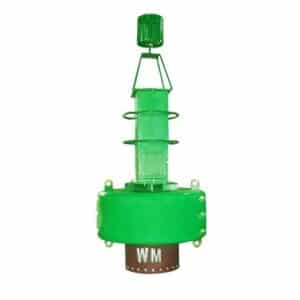
Encircled by the Indian Ocean and the South China Sea, Singapore depends on the ocean for its lifestyle and business. Thus, the marine industry in Singapore has rapidly evolved over the years. However, navigating the ocean still remains a challenge for mariners. With harsh weather conditions and other potential hazards, mariners are constantly relying on navigation tools like buoys, markers, and navigational lights for safe navigation. Using Steel buoys in Singapore waters enables mariners to access valuable weather data by measuring air temperature, wind speed, barometric pressure, and wind direction. And by utilising this information, they can understand weather patterns and predict conditions.
There are generally two types of buoys: air-filled buoys and solid buoys. These two types of buoys are used for various purposes. Take a look below for a better understanding:
Mariners use air-filled marine navigation buoys mostly in the waters of Singapore. For instance, buoys with appropriate markings recommended are used to indicate safe and navigable routes for vessels. On the other hand, inflatable buoys are often used for monitoring the weather. In addition, mariners use them to mark prohibited areas, preventing accidental entry into restricted zones.
Besides, the colour of the buoys aids in navigation. Buoys that are lit with colour approved by the local authority can indicate the presence of obstructions in the water, signalling caution, whereas green buoys (as an example) help in marking the safe route for vessels.
Uncertainty is a major obstacle in the ocean. With the high waves, sudden weather changes, fogs, debris, rocks, and other potential hazards, it’s crucial to have proper tools that can pre-alert mariners to avoid accidents. Maritime buoys and markers serve a crucial purpose by marking these obstacles in the waters of Singapore. These buoys are easy to notice from coastlines and vessels and make mariners aware of underwater obstructions and work boundaries, etc. Taking for example, a special mark buoy with Yellow Pillar and X-Topmark can be seen from a distance.
Both the Indian Ocean and the South China Sea are impacted by the cyclone almost throughout the year. Therefore, for mariners, it’s essential to have a device or tool that can assist in predicting the path and intensity of these storms.
Some marine navigation buoys are especially equipped to measure wind speed and direction, while others monitor water temperature and height. This data is used to develop models that aid in forecasting a hurricane's trajectory. The information collected by buoys also assists in generating forecasts for tides and wave heights and reduces damage.
The main objective of using buoys is to stay safe while sailing on the ocean. Made of plastic, steel, or other elements, these buoys are the saviour for mariners navigating through the waters of Singapore. They aid in navigating currents by providing information on direction and depth. They also serve as beacons for favourable weather conditions, allowing vessels to change course without concern about rough seas.
Note: This article is for reference only. Any copyright issues or intellectual property related matters (if any are involved and not made known to Wealth Marine), such accountability and responsibility shall be passed on to the writer of the articles